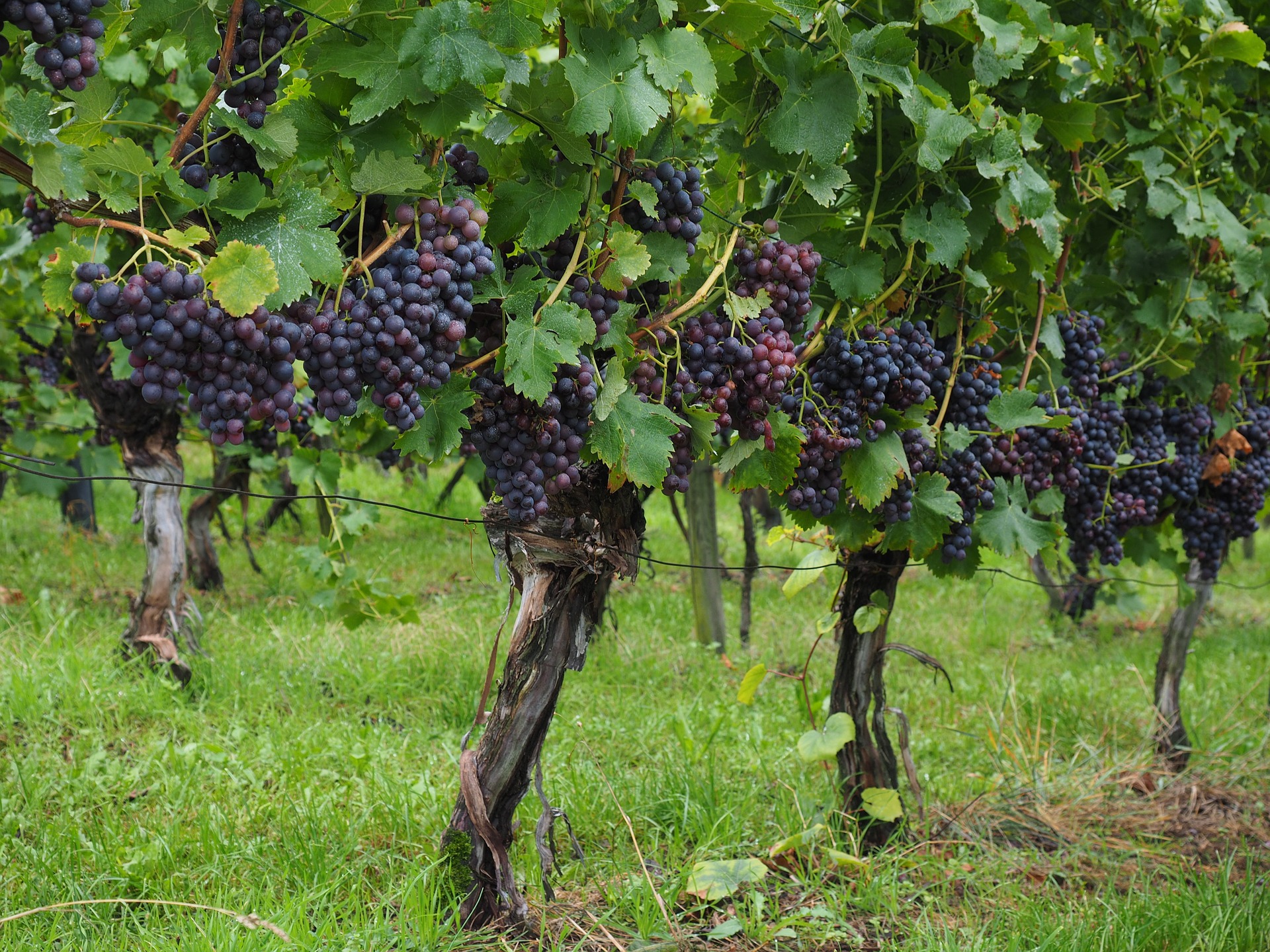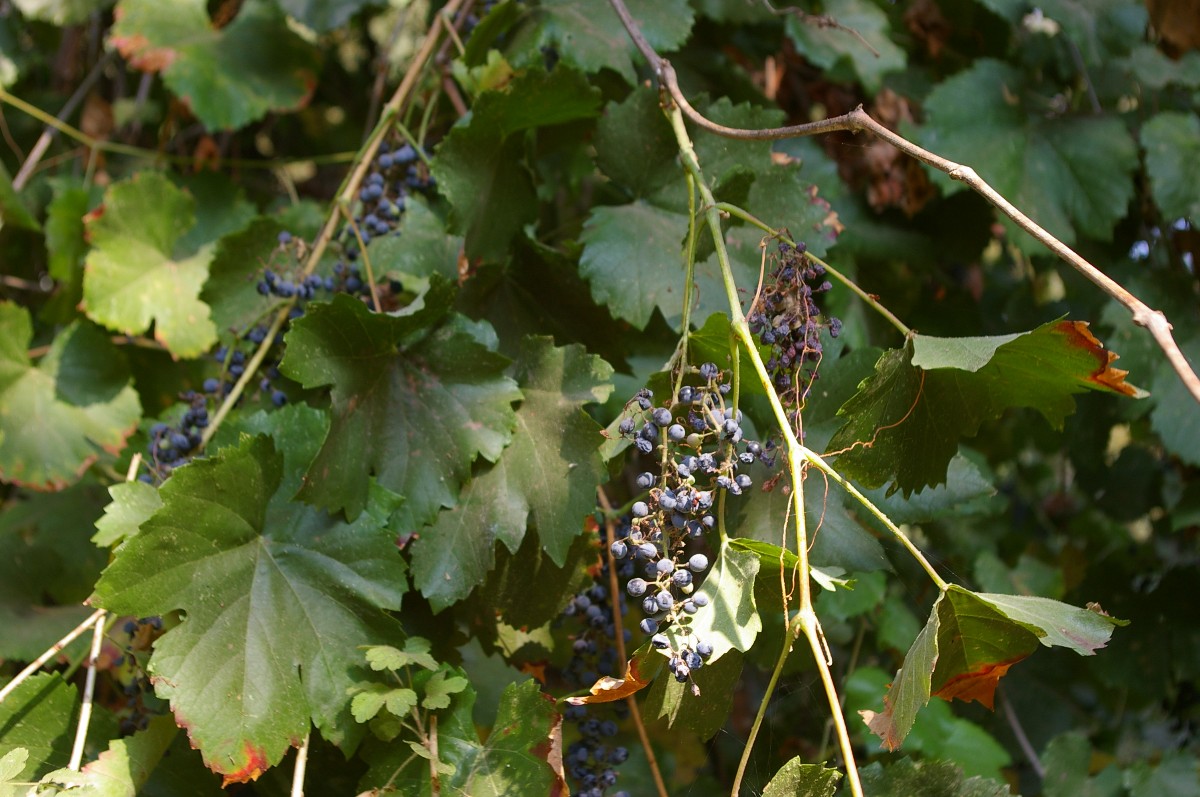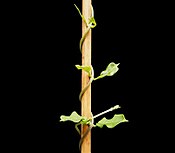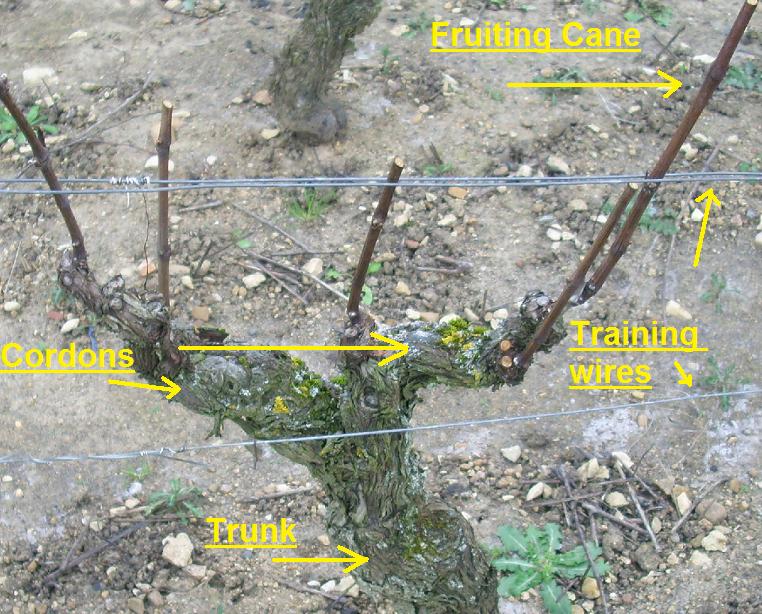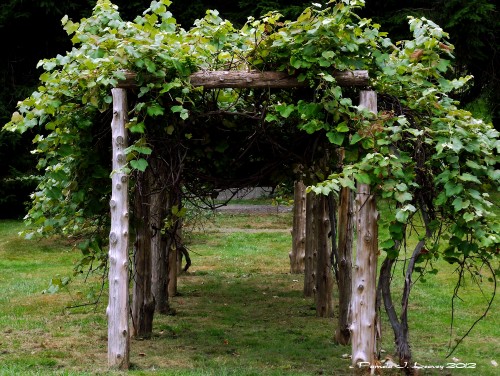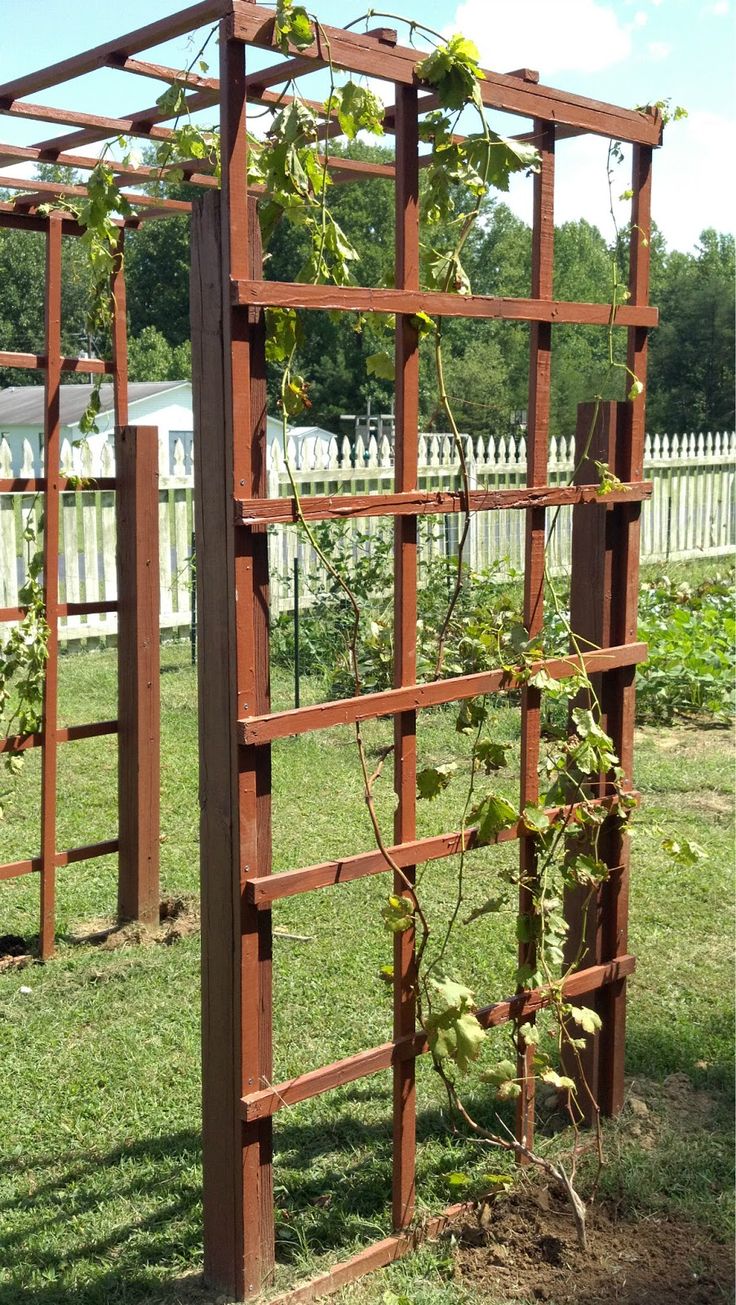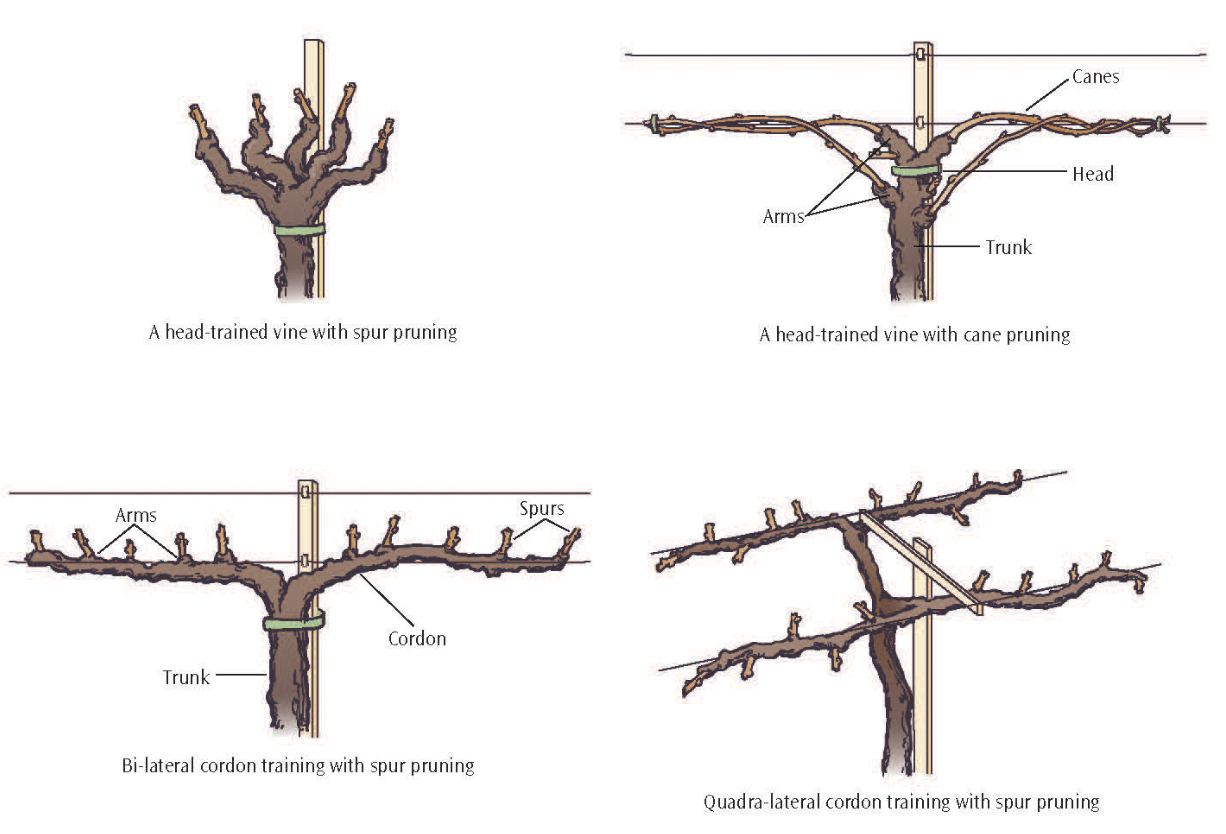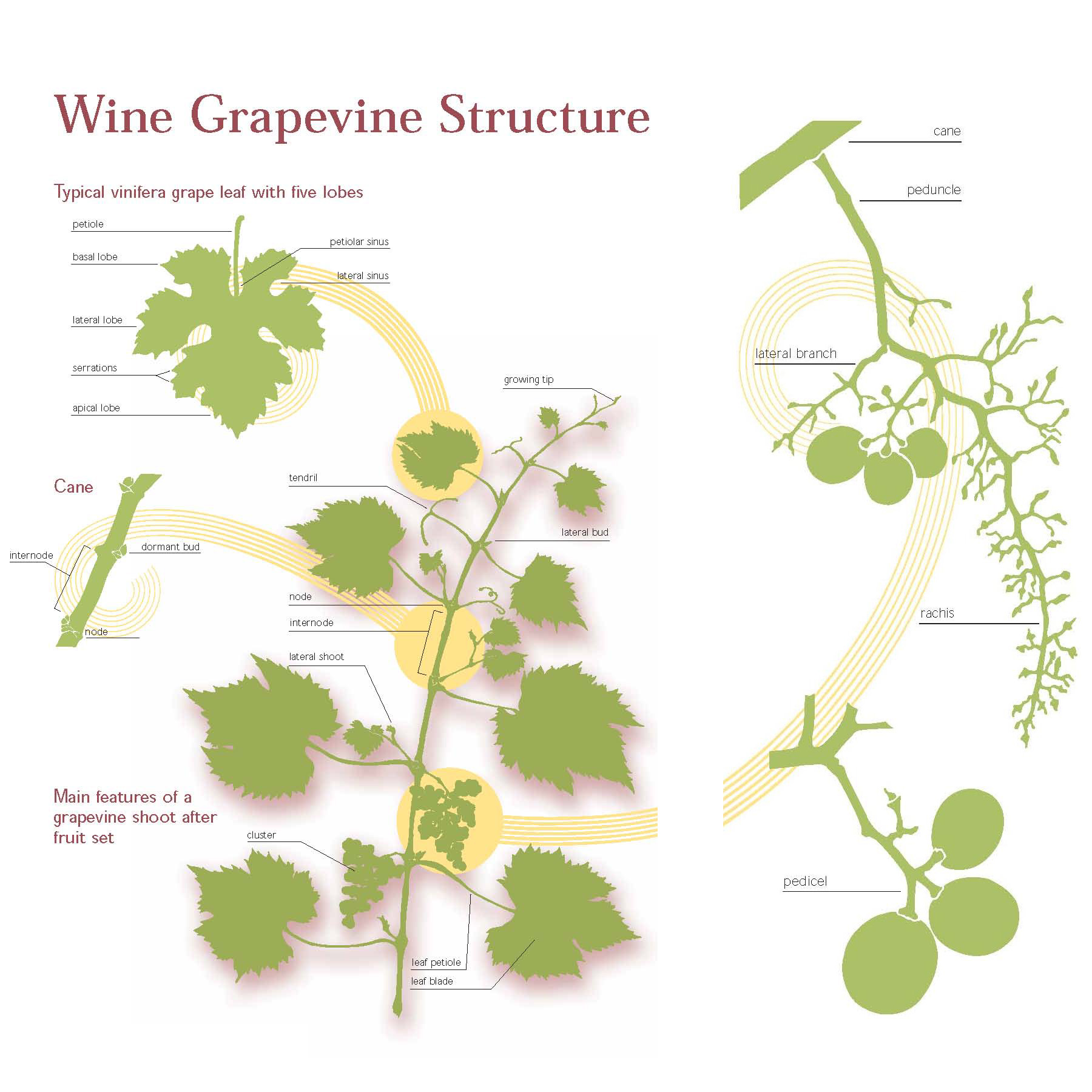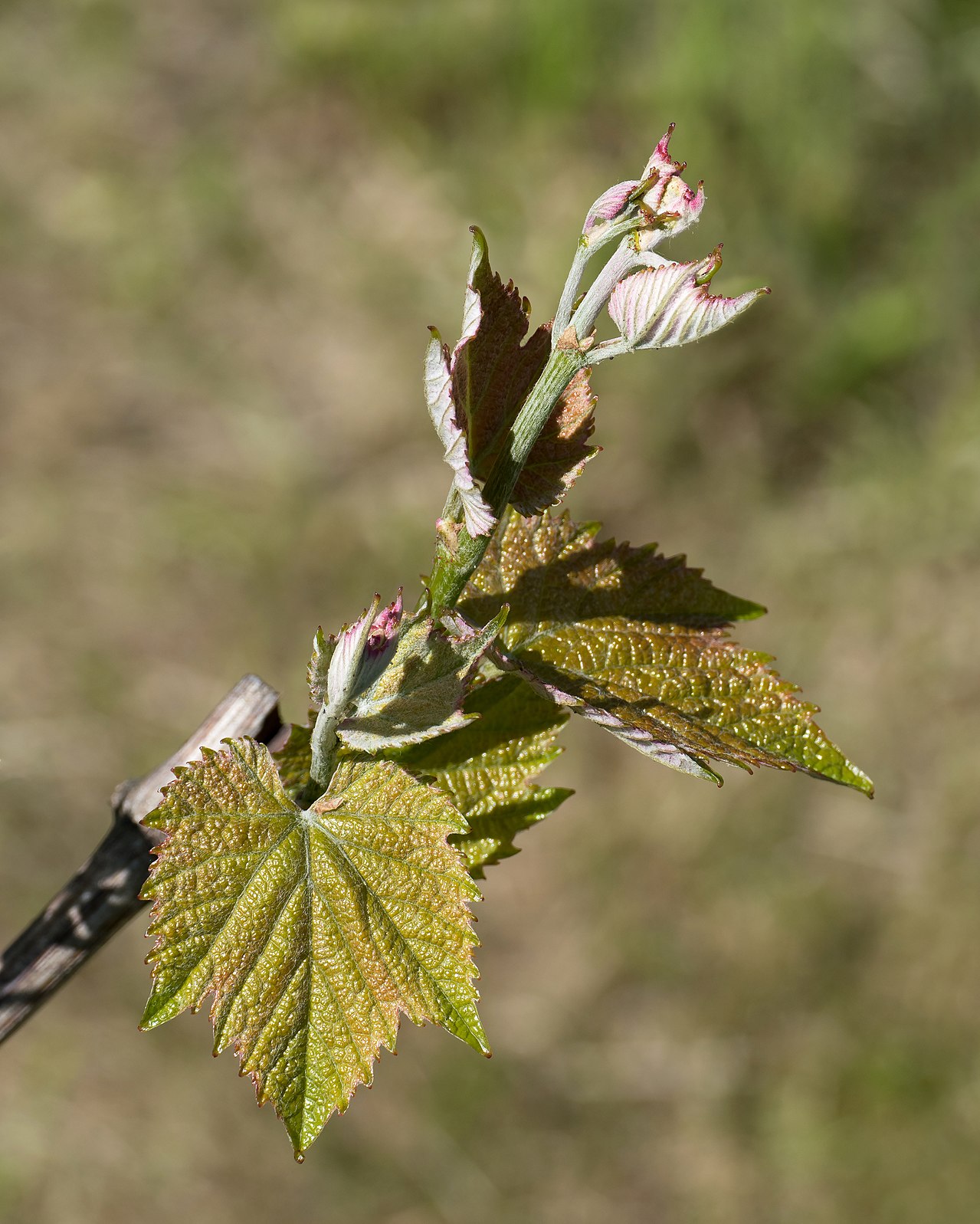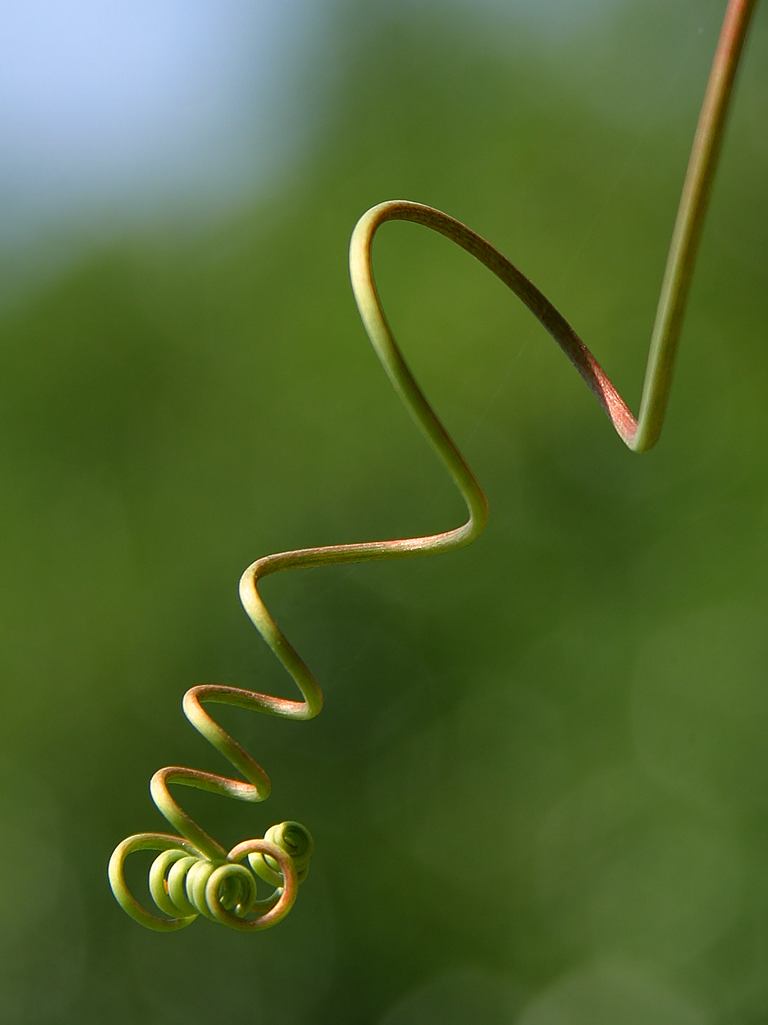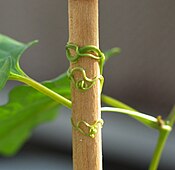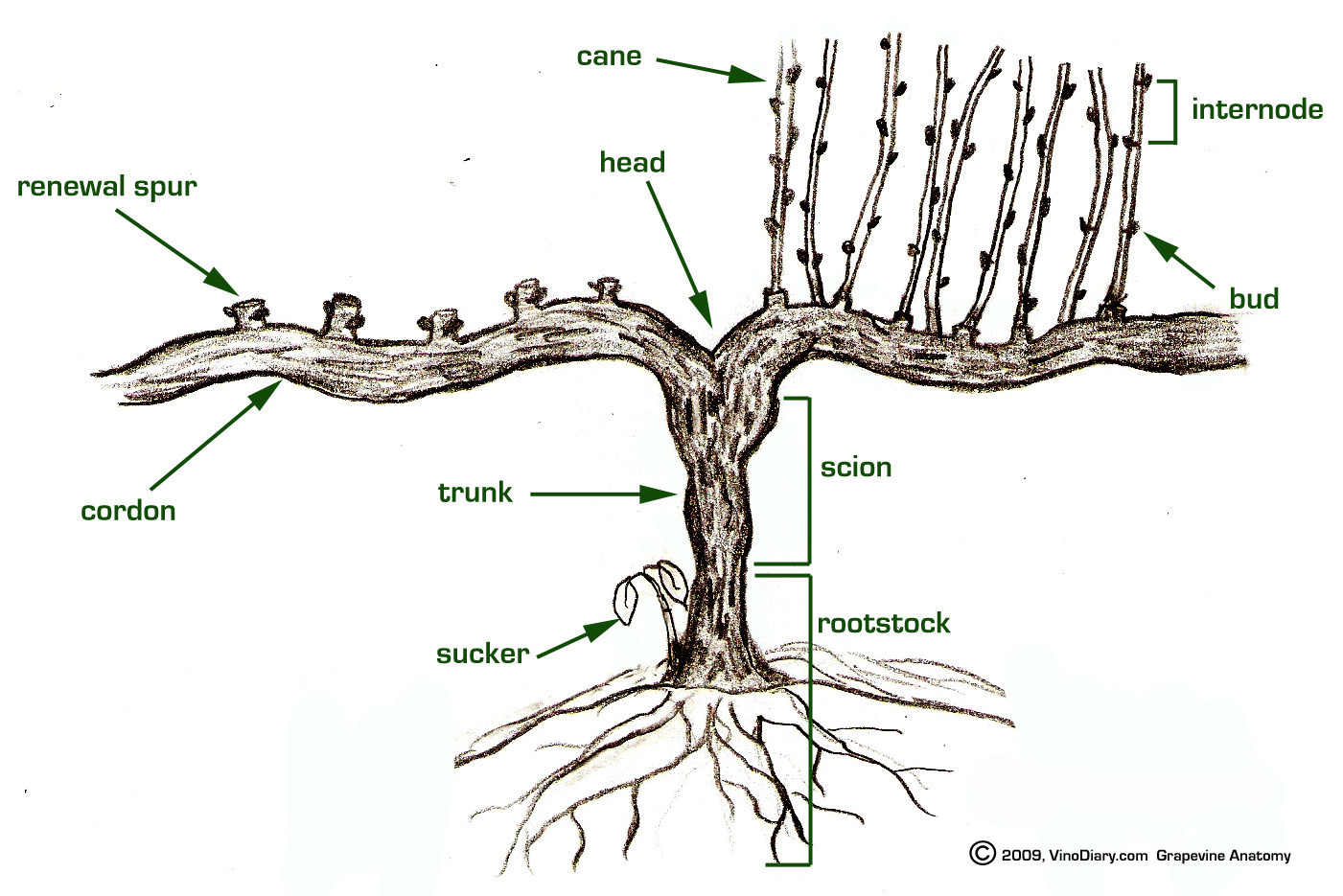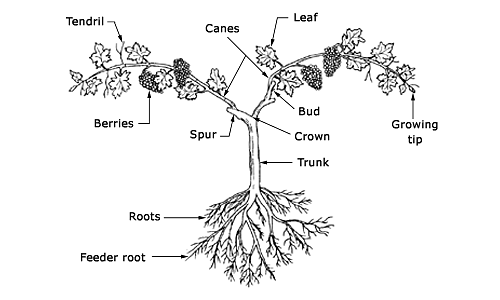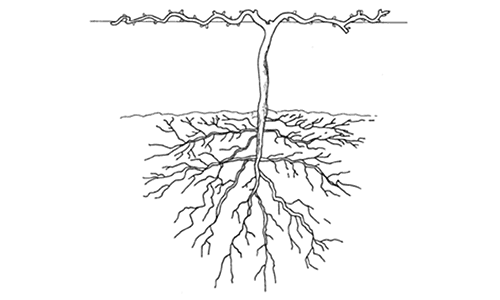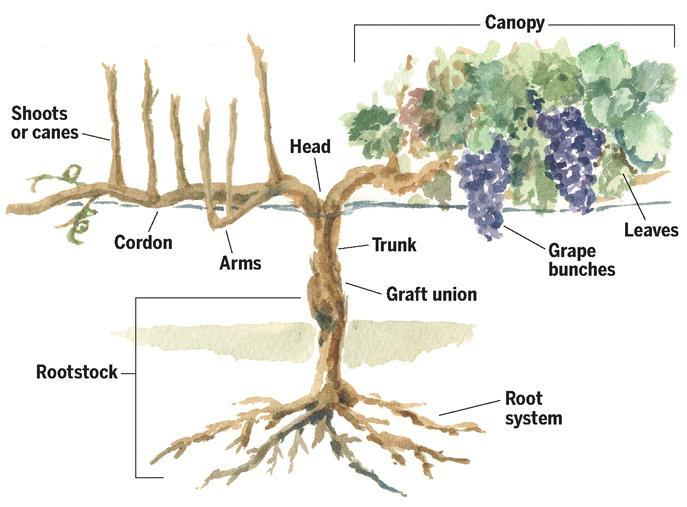The Vine and Vineyard
Vitis vinifera, the common grape vine, is a species of Vitis, native to the Mediterranean region, central Europe, and southwestern Asia, from Morocco and Portugal north to southern Germanyand east to northern Iran
- There are currently between 5,000 and 10,000 varieties of Vitis vinifera grapes though only a few are of commercial significance for wine and table grape production.
- It is a liana growing to 35 yards (32 m) in length, with flaky bark.
- The leaves are alternate, palmately lobed, 5–20 cm (2.0–7.9 in) long and broad.
- The fruit is a berry, known as a grape;
- in the wild species it is 6 mm (0.24 in) diameter and ripens dark purple to blackish with a pale wax bloom;
- in cultivated plants it is usually much larger, up to 3 cm (1.2 in) long, and can be green, red, or purple (black).
- The species typically occurs in humid forests and streamsides.
- The wild grape is often classified as V. vinifera subsp. sylvestris (in some classifications considered Vitis sylvestris), with V. vinifera subsp. vinifera restricted to cultivated forms.
- Domesticated vines have hermaphrodite flowers, but subsp. sylvestris is dioecious (male and female flowers on separate plants) and pollination is required for fruit to develop.
- The grape is eaten fresh, processed to make wine or juice, or dried to produce raisins.
- Cultivars of Vitis vinifera form the basis of the majority of wines produced around the world.
- All of the familiar wine varieties belong to Vitis vinifera, which is cultivated on every continent except for Antarctica, and in all the major wine regions of the world.
Vitis (grapevines) is a genus of 79 accepted species[5] of vining plants in the flowering plant family Vitaceae.
- The genus is made up of species predominantly from the Northern hemisphere.
- It is economically important as the source of grapes, both for direct consumption of the fruit and for fermentation to produce wine.
- The study and cultivation of grapevines is called viticulture.
- Most Vitis varieties are wind-pollinated with hermaphroditic flowers containing both male and female reproductive structures.
- These flowers are grouped in bunches called inflorescences. In many species, such as Vitis vinifera, each successfully pollinated flower becomes a grape berry with the inflorescence turning into a cluster of grapes.
- While the flowers of the grapevines are usually very small, the berries are often big and brightly colored with sweet flavors that attract birds and other animals to disperse the seeds contained within the berries.[6]
- Grapevines usually only produce fruit on shoots that came from buds that were developed during the previous growing season.
- In viticulture, this is one of the principles behind pruning the previous year’s growth (or “One year old wood”) that includes shoots that have turned hard and woody during the winter (after harvest in commercial viticulture).
- These vines will be pruned either into a cane which will support 8 to 15 buds or to a smaller spur which holds 2 to 3 buds.[6]
Symbolism
- The grapevine (typically Vitis vinifera) has been used as a symbol since ancient times.
- In Greek mythology, Dionysus (called Bacchus by the Romans) was god of the vintage and, therefore, a grapevine with bunches of the fruit are among his attributes.
- His attendants at the Bacchanalian festivals hence had the vine as an attribute, together with the thyrsus, the latter often entwined with vine branches.
- For the same reason, the Greek wine cup (cantharos) is commonly decorated with the vine and grapes, wine being drunk as a libation to the god.
- The first written accounts of grapes and wine can be found in the Epic of Gilgamesh, an ancient Sumerian text from the third millennium BC. There are also numerous hieroglyphic references from ancient Egypt, according to which wine was reserved exclusively for priests, state functionaries and the pharaoh.[8]
Uses
- Use of grapes is known to date back to Neolithic times, following the discovery in 1996 of 7,000-year-old wine storage jars in present-day northern Iran.
- Further evidence shows the Mesopotamians and Ancient Egyptians had vine plantations and winemaking skills.
- Greek philosophers praised the healing powers of grapes both whole and in the form of wine. Vitis vinifera cultivation and winemaking in China began during the Han Dynasty in the 2nd century[19] with the importation of the species from Ta-Yuan.
- However, wild vine “mountain grapes” like Vitis thunbergii were being used for wine making before that time.[20]
- In traditional medicine of India V. vinifera is used in prescriptions for cough, respiratory tract catarrh, subacute cases of enlarged liver and spleen, as well as in alcohol-based tonics (Aasavs).[21]
- In the Mediterranean Basin, leaves and young stems are traditionally used to feed sheep and goats after grapevine pruning [22]
- Using the sap of grapevines, European folk healers sought to cure skin and eye diseases.
- Other historical uses include the leaves being used to stop bleeding, pain and inflammation of hemorrhoids.
- Unripe grapes were used for treating sore throats, and raisins were given as treatments for consumption (tuberculosis), constipation and thirst.
- Ripe grapes were used for the treatment of cancer, cholera, smallpox, nausea, skin and eye infections as well as kidney and liver diseases.
- Seedless grape variety were developed to appeal to consumers, but researchers are now discovering that many of the healthful properties of grapes may actually come from the seeds themselves, thanks to their enriched phytochemicalcontent.[23][24]
- Grapevine leaves are filled with minced meat (such as lamb, pork or beef), rice and onions in the making of Balkan traditional dolma.
- A grapevine is depicted on the reverse of the Croatian 2 lipa coin, minted since 1993.
A vine (Latin vīnea “grapevine”, “vineyard”, from vīnum “wine”)
- in the narrowest sense is the grapevine (Vitis),
- and more generally, any plant with a growth habit of trailing or scandent (that is, climbing) stems, lianas or runners.
- The word also can refer to such stems or runners themselves, for instance when used in wicker work.[1][2]
- In parts of the world, the term “vine” applies almost exclusively to the grapevine,[3]
- While the term “climber” is used for all climbing plants.[4]
- Certain plants always grow as vines, while a few grow as vines only part of the time.
- For instance, poison ivy and bittersweet can grow as low shrubs when support is not available, but will become vines when support is available.[5]
- A vine displays a growth form based on long stems.
- This has two purposes.
- A vine may use rock exposures, other plants, or other supports for growth rather than investing energy in a lot of supportive tissue,
- enabling the plant to reach sunlight with a minimum investment of energy.
- This has been a highly successful growth form for plants such as kudzu and Japanese honeysuckle, both of which are invasive exotics in parts of North America.
- There are some tropical vines that develop skototropism, and grow away from the light, a type of negative phototropism.
- Growth away from light allows the vine to reach a tree trunk, which it can then climb to brighter regions.[6]
- The vine growth form may also enable plants to colonize large areas quickly, even without climbing high.
- This is the case with periwinkle and ground ivy.
- It is also an adaptation to life in areas where small patches of fertile soil are adjacent to exposed areas with more sunlight but little or no soil.
- A vine can root in the soil but have most of its leaves in the brighter, exposed area, getting the best of both environments.
- The evolution of a climbing habit has been implicated as a key innovation associated with the evolutionary success and diversification of a number of taxonomic groups of plants.[7]
- It has evolved independently in several plant families, using many different climbing methods[8] such as:
- twining their stems around a support (e.g., morning glories, Ipomoea species).
- by way of adventitious, clinging roots (e.g., ivy, Hedera species)
- with twining petioles (e.g., Clematis species)
- using tendrils, which can be specialized shoots (Vitaceae), leaves (Bignoniaceae), or even inflorescences (Passiflora)
- using tendrils which also produce adhesive pads at the end that attach themselves quite strongly to the support (Parthenocissus)
- using thorns (e.g. climbing rose) or other hooked structures, such as hooked branches (e.g. Artabotrys hexapetalus)
- The climbing fetterbush (Pieris phillyreifolia) is a woody shrub-vine which climbs without clinging roots, tendrils, or thorns.
- It directs its stem into a crevice in the bark of fibrous barked trees (such as bald cypress) where the stem adopts a flattened profile and grows up the tree underneath the host tree’s outer bark.
- The fetterbush then sends out branches that emerge near the top of the tree.[9]
- Most vines are flowering plants.
- These may be divided into woody vines or lianas, such as wisteria, kiwifruit, and common ivy, and herbaceous (nonwoody) vines, such as morning glory.
- One odd group of vining plants is the fern genus Lygodium, called climbing ferns.[10]
- The stem does not climb, but rather the fronds (leaves) do.
- The fronds unroll from the tip, and theoretically never stop growing; they can form thickets as they unroll over other plants, rockfaces, and fences.
Twining vines
- A twining vine, also known as a bine, is a climbing plant that climbs by its shoots growing in a helix,
- in contrast other vines which climb using tendrils or suckers.
- Many bines have rough stems or downward-pointing bristles to aid their grip.
- Hops (used in flavoring beer) are a commercially important example of a bine.[13][14]
- Direction of rotation
- The rotation of the shoot tip during climbing is autonomous and does not (as sometimes imagined) derive from the shoot’s following the sun around the sky –
- the direction of twist does not therefore depend upon which side of the equator the plant is growing.
- This is shown by the fact that some bines always twine clockwise,
- including runner bean (Phaseolus coccineus) and bindweed (Convolvulus species),
- while others twine anticlockwise,
- including French bean (Phaseolus vulgaris) and climbing honeysuckles (Lonicera species).
- The contrasting rotations of the bindweed and the honeysuckle was the theme of the satirical song “Misalliance”,[15] written and sung by Michael Flanders and Donald Swann.
Vine Training
- The use of vine training systems in viticulture is aimed primarily to assist in canopy management with finding the balance in enough foliage to facilitate photosynthesis without excessive shadingthat could impede grape ripening or promote grape diseases.[1]
- Additional benefits of utilizing particular training systems could be to control potential yields and to facilitate mechanization of certain vineyard tasks such as pruning, irrigation, applying pesticide or fertilizing sprays as well as harvesting the grapes.[2]
- In deciding on what type of vine training system to use, growers will also consider the climate conditions of the vineyard where the amount of sunlight, humidity and wind could have a large impact on the exact benefits the training system offers.
- For instance, while having a large spread out canopy (such as what the Geneva Double Curtain offers) can promote a favorable leaf to fruit ratio for photosynthesis, it offers very little wind protection.
- In places such as the Châteauneuf-du-Pape, strong prevailing winds such as le mistral can take the fruit right off the vine so a more condensed, protective vine training system is desirable for vineyards there.[3]
- While closely related, the terms trellising, pruning and vine training are often used interchangeably even though they refer to different things.
- Technically speaking, the trellis refers to the actual stakes, posts, wires or other structures that the grapevine is attached to.
- Some vines are allowed to grow free standing without any attachment to a trellising structure.
- Part of the confusion between trellising and vine training systems stems from the fact that vine training systems will often take on the name of the particular type of trellising involved.[4]
- Pruning refers to the cutting and shaping of the cordon or “arms” of the grapevine in winter which will determine the number of buds that are allowed to become grape clusters.[5]
- In some wine regions, such as France, the exact number of buds is outlined by Appellation d’origine contrôlée (AOC) regulations.
- During the summer growing season, pruning can involve removing young plant shoots or excess bunches of grapes with green harvesting.
- Vine training systems utilize the practice of trellising and pruning in order to dictate and control a grape vine’s canopy which will influence not only the potential yield of that year’s crop but also the quality of the grapes due to the access of air and sunlight needed for the grapes to ripen fully and for preventing various grape diseases.[6]
History
- As one of the world’s oldest cultivated crops, grapevines have been trained for several millennia.
- Cultures such as the ancient Egyptians and Phoenicians discovered that different training techniques could promote more abundant and fruitful yields.
- When the Greeks began to colonize southern Italy in the 8th century BC, they called the land Oenotria which could be interpreted as “staked” or land of staked vines.
- In the 1st century AD, Roman writers such as Columella and Pliny the Elder gave advice to vineyard owners about what type of vine trainings worked well for certain vineyards.[7]
- For most of history, regional tradition largely dictated what type of vine training would be found in a given area.
- In the early 20th century, many of these traditions were codified into specific wine laws and regulations such as the French Appellation d’Origine Contrôlée (AOC) system.
- The widespread study and utilization of various training systems began in the 1960s when many New World wine regions were developing their wine industry.
- Without the centuries of tradition that influenced Old world winemaking and viticulture, vine growers in areas like California, Washington, Australia and New Zealand conducted large scale research into how particular vine training systems, pruning and canopy management techniques impacted wine quality.
- As research in this area continued into the 21st century, new vine training systems were developed that could be adapted to the desired wine making style the grapes were destined for as well as the labor needs and particular mesoclimate of the vineyard.[2]
Purpose
Most vine training systems are designed to ensure adequate sunlight and air circulation throughout the canopy such as these Lyre trained vines in Napa Valley.
- While the most pertinent purpose of establishing a vine training system is canopy management, especially dealing with shading, there are many other reasons that come into play.
- As members of the Vitis family, grapevines are climbing plants that do not have their own natural support like trees.
- While grapevines have woody trunks, the weight of a vine’s leafy canopy and grape clusters will often bring the vine’s cordon or “arms” down towards the ground unless it receives some form of support.[8]
- In viticulture, growers want to avoid any part of the cordon from touching the ground because of the vine’s natural inclination to send out suckers or basal shoots and take root in that area where the cordon is touching the ground.
- Ever since the phylloxera epidemic of the 19th century, many vines are grafted on phylloxera resistant rootstock.
- However, the “top part” of the grafted vine is still very susceptible to the phylloxera and should a part of that vine take root both the daughter and the original mother vine will risk being infected by the louse.
- Additionally this daughter vine will leech resources of water and nutrients from the mother vine which can diminish the quality of both vines’ grape production.[3]
- Other reasons for vine training involve setting up the vineyard and each individual vine canopy for more efficient labor usage or mechanization.
- Vines that are trained to have their “fruiting zone” of grape clusters at waist to chest height are easier for vineyard workers to harvest without straining their bodies with excessive bending or reaching.
- Similarly, keeping the fruiting zone in a consistent spot on each vine makes it easier to set up machinery for pruning, spraying and harvesting.[2]
The impact of excessive shading
- Many vine training systems are designed to avoid excessive shading of the fruit by the leafy growth (the “canopy”).
- While some shading is beneficial, especially in very hot and sunny climates, to prevent heat stress, excessive amounts of shading can have negative impact on grape development.
- As a photosynthetic plant, grapevines need access to sunlight in order to complete their physiological processes.
- Through photosynthesis, less than 10% of the full sunlight received by a leaf is converted into energy which makes obstacles such as shading even more detrimental to the plant.
- Even if the leaves at the top of the canopy are receiving plenty of sunlight, the young buds, grape clusters and leaves below will still experience some negative impact.
- During the annual growth cycle of the grapevine, excessive shading can reduce the success rate of bud formation, budbreak, fruit set as well as the size and quantity of grape berries on a cluster.[2]
- The grape clusters receive some benefit from receiving direct sunlight through enhanced ripening of various phenolic compounds that can contribute to a wine’s aroma and quality.
- In addition to having decreased physiological ripeness, excessive shade will negatively impact a grape’s quality by causing increases in the levels of potassium, malic acid and pH in the grapes while decreasing the amount of sugar, tartaric acid and color producing anthocyanins.
- Beyond a lack of sunlight, excessive shading limits the amount of air circulation that can take place within a vine’s canopy.
- In wet, humid climates poor air circulation can promote the development of various grape diseases such as powdery mildewand grey rot.[2]
Components of a grapevine Main article: Canopy (grape)
- While the term canopy is popularly used to describe the leafy foliage of the vine, the term actually refers to the entire grapevine structure that is above ground.
- This includes the trunk, cordon, stems, leaves, flowers, and fruit.
- Most vine training deals primarily with the “woody” structure of the vine-the cordons or “arms” of the vine that extend from the top of the trunk and the fruiting “canes” that extend from the cordon.
- When the canes are cut back nearly to the base of the cordon, the shortened stub is called a “spur”.
- Grapevines can either be cane trained or spur trained.
- In cane training,
- the grapevines are “spur pruned”
- meaning that in the winter the fruiting canes are pruned essentially down to their spurs with over 90 percent of the previous year’s growth (or “brush” as it is known) removed.
- Examples of cane training systems include the Guyot, Mosel arch and Pendelbogen.
- Conversely, spur trained vines
- are “cane pruned” meaning that the individual canes are relatively permanent with only excess buds at the end of the cane being removed.[3]
- Cordons are trained in either a unilateral (one arm) or bilateral (two arms) fashion with the latter resembling the letter “T”.
- The cordons of grapevines are most commonly trained horizontally along wires as in the Lyre and Scott Henry systems.
- However, notable exceptions do exist,
- such as the “V” and “Y” trellis systems
- which elevate the cordon to various angles that resemble their namesake letter.
- Note that vertical trellising systems, such as the VSP system often used in New Zealand, refer to the vertical orientation of the fruit canes in an upward manner and not the cordon “arms” of the vines.[6]
- From the cordon, plant shoots emerge from the bud that eventually develops mature bark and becomes the fruiting cane from which grape clusters will emerge.
- These canes can be positioned and trained to whatever angle is desired by the grower.
- Typically, they are positioned upwards but they can be bent into an arch such as a Pendelbogen or Mosel arch system, or trained to point downwards such as the Scott Henry and Sylvos system.
- The latter method requires more labor-intensive trellising and training for Vitis vinifera vines which are naturally more inclined to grow upwards rather than down.
- In systems such as the Scott Henry, this downward growth is achieved by the use of movable wires that first allow the canes to grow upwards until about 2 to 3 weeks before harvest when they are then shifted downwards where the weight of gravity on the hanging grape clusters helps keep the canes pointing down.[2]
- The leafy foliage of a grapevine’s canopy will be dependent on the particular grape variety and its propensity for vigorous growth.
- These leaves emerge from shoots on the fruiting cane in a manner similar to the grape clusters themselves.
- A vine is described as “vigorous” if it has a propensity to produce many shoots that are outwardly observable as a large, leafy canopy.
- The ability of the grapevine to support such a large canopy is dependent on the health of its root system and storage of carbohydrates.[8]
- If a vine does not have a healthy and extensive root system in proportion to its canopy, then it is being overly vigorous with parts of the vine (most notably the grape clusters) suffering due to lack of resources.
- While it may seem that more foliage would promote increased photosynthesis (and such carbohydrate production), this is not always the case since the leaves near the top of the canopy create excess shading that hinders photosynthesis in the leaves below.
- One of the objectives of vine training is to create an “open canopy” that allows limited excess leaf growth and allows plenty of sunlight to penetrate the canopy.[2]
Classification of different systems
- Vine training systems can be broadly classified by a number of different measurements.
- One of the oldest means was based on the relative height of the trunk with the distance of the canopy from the ground being described as
- high-trained (also known as “high culture” or vignes hautes)
- or low-trained (vignes basses).
- The ancient Romans were adherents of the high-trained vine systems with the tendone system of vines trained high over head along a pergola being one example.
- In the 1950s, Austrian winemaker Lenz Moser advocated the high-culture style of training, recommending low density plantings of vines with trunks 4 ft (1.25 m) high.
- One of the benefits of a high-trained system is better frost protection versus low-trained systems such as the gobelet training system which tend to hang low to the ground.
- Some training systems such as the Guyot and cordons can be adapted to both high and low trained styles.[2]
- One of the most common manners of classifying vine training systems now is based on which parts of the vines are permanent fixtures which determines which parts of the vine are removed each year as part of the winter pruning.
- With a cane-trained system, there are no permanent cordons or branches that are kept year after year.
- The vine is pruned down to the spur in winter, leaving only one strong cane which is then trained into becoming the main branch for next year’s crop.
- Examples of cane trained systems include the Guyot and Pendelbogen.
- With spur-trained systems, the main branch or cordon is kept each year with only individual canes being pruned during the winter.
- While vines that are cane trained will often have a thin, smooth main branch, spur trained vines will often have thick, dark and gnarled cordon branches.
- Many old vine vineyards will often utilize spur training system.
- Some examples of spur-training systems include the goblet or bush vine systems, and Cordon de Royat.
- Some systems, like the Scott Henry and VSP Trellis, can be adapted to both spur and cane training.[3]
- Vine systems that are classified as either cane or spur trained may be alternately described by the way they are pruned in the winter so systems that are described as “cane-trained” will be spur pruned while systems that are “spur-trained” will be cane-pruned.[2]
- Within these larger classifications, the vine training system may be further distinguished by the canopy such as whether it is free (like goblet) or constrained by shoot positioning along wires (such as VSP trellising) and whether it includes a single curtain (Guyot) or double (Lyre).
- For cordon and many other spur trained systems, they could be described as unilateral (utilizing only 1 arm or cordon) or bilateral with both arms extending from the trunk.[2]
- Two other classifications, based on trellising, are whether or not the vine is “staked” with an external support structure and the number of wires used in the trellising.
- Vines may be individual staked either permanently, as many vineyards along the bank of the Rhone Valley which are at risk of wind damage, or temporarily as some young vines are to provide extra support.
- Within a trellis system fruiting canes and young shoots are attached to wires strung out across the rows.
- The number of wires used (one, two, three) and whether or not they are movable (such as the Scott Henry) will influence the size of the canopy and the yield.[4]
A grape vine needs to be trained to a support beam to grow upward, and also cuts off the risk of disease.
The Trunk
The trunk is permanent and supports the arms of the grape vine. Illustration courtesy of Eric Stafne, Mississippi State University.
- The trunk, which was formerly an individual shoot trained as the trunk in a young vine,
- becomes permanent and supports the above-ground vegetative (leaves and stems)
- and reproductive (flowers and fruits) structures of the vine.
- The height of the trunk varies with the training system selected.
- For cane-pruned training systems, the top of the trunk is referred to as the head.
- The height of the head
- is determined by pruning during the initial stages of training a young grapevine
- (or replacement trunk).
- The trunk of a mature vine will have arms,
- short branches from which canes and/or spurs originate,
- are located in different positions depending on the system.
- Some training systems utilize cordons, semi-permanent branches of the trunk.
- Cordons are usually trained horizontally along a trellis wire,
- with spurs spaced at regular intervals along their length.
- Where bilateral training systems are used,
- the cordon is trained to either side of the trunk,
- and some growers refer to each of the two sides of the cordons as arms.
- Other systems utilize canes, one-year-old wood arising from arms and usually located near the head of the vine.
- Multiple trunks are often used in grape growing regions that are at risk for winter injury.
- The term “crown” refers to the basal region of the trunk slightly below and above the soil level.
Shoots
New green growth with leaves, tendrils, and often flower clusters, developing from a bud of a cane or spur
The shoot consists of
- stems,
- leaves,
- tendrils,
- and fruit
- and is the primary unit of vine growth
- and the principal focus of many vineyard management practices.
- Shoots arise from compound buds that are initiated around bloom
- during the previous growing season.
- Each compound bud can potentially produce more than one shoot.
- Primary shoots arise from primary buds (described below)
- and are normally the fruit-producing shoots on the vine.
- The main axis of the shoot consists of
- structural support tissues
- and conducting tissues
- to transport water, nutrients, and the products of photosynthesis.
- Arranged along the shoot in regular patterns are
- leaves,
- tendrils,
- flower or fruitclusters,
- and buds.
- General areas of the shoot are described as
- basal (closest to its point of origin),
- mid-shoot,
- and apex (tip).
- The term canopy is used to describe the collective arrangement
- of the vine’s shoots, leaves and fruit;
- some viticulturists also include the trunk, cordons and canes.
Shoot tip
- The shoot has many points of growth that will be described in more detail below,
- but the main shoot growth in length occurs from the apical meristem,
- located at the shoot tip.
- New leaves and tendrils unfold from the tip as the shoot grows.
- Growth rate of the shoot varies during the season.
- Grapevine shoots do not stop expanding by forming a terminal bud as some plants do,
- but may continue to grow if there is sufficient heat, soil moisture, and nutrients.
- Leaves are produced at the apical meristem.
- The shoot produces two or more closely spaced bracts (small scale-like leaves) at its base before it produces the first true foliage leaf (Pratt, 1974).
- Leaves are attached at the slightly enlarged area on the shoot that is referred to as a node.
- The area between nodes is called the internode.
- The distance between nodes is an indicator of the rate of shoot growth, so internode length varies along the cane corresponding to varying growth rates during the season.
- Leaves consist of the blade, the broad, flat part of the leaf designed to absorb sunlight and CO2 in the food manufacturing process of photosynthesis, and the petiole, the stem-like structure that connects the leaf to the shoot.
- The lower surface of leaf blade contains thousands of microscopic pores called stomata (singular = stomate), through which diffusion of CO2, O2, and water vapor
- Tendril supported vine (Brunnichia ovata)
- occurs.
- Stomata are open in the light and closed in the dark.
- The petiole conducts water and food material to and from the leaf blade, and maintains the orientation of the leaf blade to perform its functions in photosynthesis.
Tendrils
- The shoot also produces tendrils, slender structures that coil around smaller objects
- (i.e., trellis wires, small stakes, and other shoots) to provide support for growing shoots.
- Tendrils grow opposite a leaf at the node, except the first two or three leaves at the base of the shoot.
- Thereafter, tendrils can be found opposite leaves, skipping every third leaf.
- Flower clusters and tendrils have a common developmental origin (Mullins et al., 1992), so occasionally a few flowers will develop on the end of a tendril.
Buds
- A bud is a growing point that develops in
the leaf axil, the area just above the point of connection between the petiole and shoot.
- The single bud that develops in this area is described in botanical terms as an axillary bud.
- On grapevines, a bud develops in every leaf axil, including the inconspicuous basal bracts (scale-like leaves).
- In viticulture terminology, the two buds associated with a leaf are termed the lateral bud and the dormant bud (or latent bud).
- The lateral bud is the true axillary bud of the foliage leaf, and the dormant bud forms in the bract axil of the lateral bud.
- Because of their developmental association, the two buds are situated side-by-side in the main leaf axil.
- Each bud is a compound bud, containing three distinct growing points, each capable of producing a shoot.
- These are commonly referred to as the primary, secondary, and tertiary buds, respectively.
- At bud burst, the primary bud is typically the only bud that begins to grow.
- If the primary bud is damaged, then the secondary and/or tertiary buds are released from dormancy and grow in place of the primary bud.
- These secondary and tertiary buds generally have little to no fruit in comparison to the primary bud.
Suckers and Watersprouts
- Latent buds embedded in older trunk and cordon wood may also produce shoots.
- Suckers are shoots that grow from the crown area of the trunk.
- Watersprout is sometimes used to refer to a shoot arising from the upper regions of the trunk or from cordons (Winkler et al., 1974).
- Buds growing from older wood are not newly initiated buds, but rather they developed on green shoots as axillary buds that never grew out.
- These latent buds can remain dormant indefinitely until an extreme event such as injury to the vine or very severe pruning stimulates renewed development and shoot growth (Winkler et al., 1974).
- Suckers often arise from latent buds at underground node positions on the trunk.
- In routine vine management, suckers are removed early in the season before axillary buds can mature in basal bracts of the sucker shoots.
- Similarly, above-ground suckers are typically stripped off the trunk manually so a pruning stub does not remain to harbor additional latent buds that could produce more suckers in the following year.
- Latent buds come into use when trunk, cordon, or spur renewal is necessary.
- Generally, numerous latent buds exist at the “renewal positions” (a pruning term) on the trunk or cordons.
- Dormant secondary and tertiary buds exist in the stubs that remain after canes or spurs have been removed by pruning.
- The shoot enters a transitional phase, starting around veraison, when it begins to mature or ripen.
- Shoot maturation begins at the shoot base as periderm develops, starting at the shoot base, appearing initially as a yellow, smooth “skin”, and continues to form outward toward the shoot tip through the remainder of summer and fall.
- As periderm develops, it changes from yellow to brown, and becomes a dry, hard, smooth layer of bark.
- During shoot maturation, the cell walls of ray tissues thicken and there is an accumulation of starch (storage carbohydrates) in all living cells of the wood and bark (Mullins et al., 1992).
- Once the leaves fall from the vine at the beginning of the dormant season, the mature shoot is considered a cane.
- The cane is the principal structure of concern in the dormant season, when pruning is employed to manage vine size and shape, and to control the quantity of potential crop in the coming season.
- Because a cane is simply a mature shoot, the same terms are used to describe its parts.
- Pruning severity is often described in terms of the number of buds retained per vine or bud count.
- This refers to the dormant buds, which in a single bud contains three growing points as described above.
- When considering a dormant cane, the buds located at the very base of a cane include secondary and tertiary growing points that give rise to the axillary buds of the shoot’s basal bracts (Pratt, 1974).
- It should be noted that the most basal buds on a cane are generally not fruitful and do not grow out, so they are not included in bud counts.
- These are often referred to as non-count buds during the pruning process.
- Canes can be pruned to varying lengths, and when they consist of only one to four buds, they are referred to as spurs, or often, fruiting spurs.
- Grapevine spurs should not be confused with true spurs produced by apple, cherry, and other fruit trees, which are the natural fruit-bearing structures of these trees.
- On grapevines, spurs are created by short-pruning of canes.
- Training systems that use cane-pruning also use spurs for the purpose of growing shoots to be trained for fruiting canes in the following season.
- These spurs are known as renewal spurs, indicating their role in replacing the arms.
Pruning
- Proper pruning will help maintain a grapevine’s potential of
- producing a good quality fruit crop,
- develop good vine structure,
- increase sunlight exposure into the canopy,
- promote the development of next year’s fruiting wood,
- and potentially reduce disease and insect pressure.
- The key to good pruning is learning how to select good quality fruiting wood to leave for cropping.
- As green shoots mature in the late summer and fall, they will begin to harden-off by developing a periderm (bark layer) that is reddish-brown in color.
- Healthy shoots will harden-off the full length of the shoot.
- Any green growth (generally at the tip) remaining at frost will be killed.
- Proper pruning can help to reduce the amount of unproductive wood and balance the level of fruit crop with the overall vegetative growth each year.
- Once pruning is completed, the remaining fruiting wood should be spread out over the entire allotted space for the vine on the trellis.
How do I prune my grapevines after the first year of growth?
- In the first growing season,
- remove all fruit and unwanted lateral shoots
- from the young vines throughout the growing season.
- Grapevines tend to grow rapidly from the apical end (main growing point)
- when lateral shoots and fruit are removed.
- Vines should be staked and tied (using twine or string)
- to allow the new shoot to form a straight trunk (Figure 1).
Figure 1. Grapes should be trained to an appropriate position on the trellis or arbor.
- The leaves should remain on the developing trunk
- to produce necessary carbohydrates to feed the plant;
- all lateral shoots, however, should be removed.
- Only lateral shoots at the top wire will be left.
- New growth may reach the top wire (around 5 to 5½ feet) during the first year.
- If this occurs,
- pinch off the end of the shoot(s) at the top wire and
- then the lateral shoots will grow horizontally in both directions along the top wire.
- These will be used to form the new cordons.
- Pruning of one-year-old hardwood (dormant canes) will be minimal,
- but some pruning may be necessary to help shape the vine before second-year growth begins.
How do I prune my grapevines after the second year of growth?
- Remove all fruit and any lateral shoots that emerge along the trunk of the grapevine.
- If vines did not complete their structural development in the first year,
- be sure to train new shoot growth
- so that the grapevine will completely cover the intended area along the trellis or arbor.
- Once the lateral shoots have grown along the top wire to the desired location,
- pinch the terminal ends of the main lateral shoots (on the top wire).
- This will force secondary shoots to develop along the two main laterals laid down to established the cordon.
- The cordon is a permanent structure that exists on the top wire,
- from which hardwood canes (hardened-off shoots) are pruned (Figure 2).
Figure 2. Further training and pruning are conducted to develop the grapevine structure.
- Lateral shoots that emerge from the cordon should be allowed to grow uninterrupted.
- Only necessary shoot positioning should be done to direct growth in an orderly manner.
- During late February or March,
- each one-year-old cane (dormant cane)
- that grew along the cordon should be pruned back to either
- a three-, four-, or five-node spur (fruiting spur)
- or a one-node renewal spur (vegetative spur).
- The remaining fruiting wood should be approximately pencil size in diameter.
- Renewal spurs produce vegetative shoots that are used for the following year’s fruiting wood.
How do I prune my grapevines after the third year of growth?
- Year three is the first fruiting year.
- Dormant pruning should be done some time in late February through March (Figure 3a and 3b).
Figure 3a. Non-pruned grapevine.
Figure 3b. Pruned grapevine.
- 1-year-old wood (dormant canes) should be pruned back to 3-, 4-, or 5-node spurs (Figure 4).
Figure 4. Bud counts for different length of spurs.
- The spurs should be evenly spaced along the cordon and pointing downward.
- To determine how many buds to retain for fruiting, weigh all pruned 1-year-old wood.
- Use the pruning weight to count the number of fruiting buds to leave.
- You may choose to use different approaches for determining the number of fruiting buds to leave.
- One system is the 30-10-10,
- which requires the person pruning to keep track of the weighed prunings
- and the number of buds remaining on the intact vine.
- For the first pound of pruned-off wood, leave 30 buds;
- second pound of wood, leave 10 buds;
- and continue adding 10 buds for each pound of wood thereafter.
- For example:
- Three pounds of one-year-old wood have been pruned off;
- a total of 50 fruiting buds should be retained on the vine.
How do I prevent my grapevines from becoming a tangled mess?
- Many times grape gardeners find that the one-year-old canes have become intertwined along the trellis and are extremely hard to unwind for pruning.
- This can be controlled somewhat by shoot positioning.
- It is very similar to combing hair.
- Once green shoots are developed enough (approximately mid-July), each shoot can be placed in an orderly position along the entire cordon of the vine and parallel to the vertical trunk.
- Combing or shoot positioning can help to reduce the overall number of tangled shoots and can increase light penetration into the vine canopy.
- Increased sunlight exposure will promote good quality fruit, better winter hardiness of canes and more productive canes for next year’s crop.
- As Figure 5a shows, an uncombed vine will have several one-year canes trailing in different directions.
- A combed vine appears much neater, has better order and canes can be pruned quicker than uncombed vines (Figure 5b).
- Grapevine combing should be done each year so that all shoots are properly positioned along the trellis.
Figure 5a. Non-shoot positioned grapevine. Figure 5b. Shoot positioned grapevine.
Summary
- Grapevines need proper training and pruning during the first three years.
- Once they start producing fruit, annual pruning is needed to maintain the balance between vegetative growth and fruit production.
- If grapevines produce too much fruit in one year, they will not produce a good crop next year and could suffer winter damage.
- If grapevines produce too little fruit one year, they will produce too many shoots and leaves that year.
Glossary of Pruning Terms
- Cane: A green summer shoot matures (hardens off) into a woody, brown one-year-old cane after leaf fall.
- Cordon: A permanent extension of the grapevine’s trunk that is horizontally positioned along the trellis (arbor) wire.
- Fruiting Wood: One-year-old wood that produces the current season’s shoots and fruit.
- Node: The thickened portion of a shoot or cane where the leaf petiole is attached and a compound bud is located.
- Pruning: Removal of portions of a grapevine for the purpose of maintaining size, shape and productivity.
- Renewal Spur: A cane pruned to one node with the primary purpose of producing a vegetative shoot (cane) for next year’s fruiting wood.
- Shoot: The green, leafy growth that develops from the compound bud that normally produces fruit clusters.
- Shoot Positioning (Combing): New shoots are positioned in an orderly manner along the trellis to allow for more even sunlight exposure on the canopy of leaves and reduce the number of canes that are tangled.
- Spur: A cane pruned to three to five fruiting nodes to produce shoots bearing fruit clusters.
- Trunk: The main, upright structure(s) of the grapevine from which cordons, shoots and canes arise.
- Grapevines tend to have deeper and less dense root systems than many other plants, so it’s important to plant grapes in deep soils whenever possible.
- The health of a grapevine plant is often an indicator of its root growth.
- Grapevine root systems also vary somewhat, depending on the variety of grape.
Root Depth
- About 60 percent of grapevine roots sit in the top 24 inches of soil, but many of the plant roots grow much deeper.
- Grape roots can grow more 20 feet deep.
- You can dig down into the soil while grapevines are dormant to check the vigor of the roots and the quality of the soil, notes Australian Cooperative Research Centre for Viticulture.
Root Spread
- Grapevine roots are generally less dense and spread out than many other plants, but they can still spread a great distance from the main vine trunk.
- University of California, Davis, Department of Viticulture & Enology notes some studies suggest that the roots can spread as far as 33 feet.
- Most of the root density is closer to the trunk, but a significant amount is sometimes more than three feet away from the trunk.
- About 15 percent of root biomass is 47 to 59 inches from the trunk.
- Soil texture and pH affect the development of grapevine root systems.
- As soil acidity, density and poor water movement increase, root vigor decreases.
- Compacted and shallow soils lead to roots that grow out horizontally instead of deeply.
- Grapevines in soils with coarse textures have less dense roots than those in fine-textured soils.
- Soils with layered profile changes, such as layers containing lots of stones or clay layers, have inconsistent root distribution.
Effects of Irrigation
- Available moisture in the soil encourages the growth of root systems.
- For table grapes, you want the vines to grow as vigorously as possible.
- On the other hand, winemakers often want the vines to struggle a bit.
- A struggling plant will produce fewer grapes with a stronger flavor and more complexity, which produces high-quality wine.
- One way to increase grape production is to weed the area around the grapes so other plants do not compete with grape roots for soil moisture.
- Winemakers sometimes intentionally do the opposite and plant a grass covering to reduce the amount of moisture in the topsoil.
God divorced them and Jesus was the new seed planted by God, to redeem the “lost sheep” (from Rachel/Joseph/Ephraim), to bring them back into covenant relationship with him by keeping the commandments, with the promise now of Eternal Life.
- He took the curse for us in the Law of Jealousies, and was made a curse for us.
- He drank the bitter water in the Garden of Gethsemene that made belly to swell and thigh to rot.
A grape seed is planted in early spring (April Passover when He was crucified)
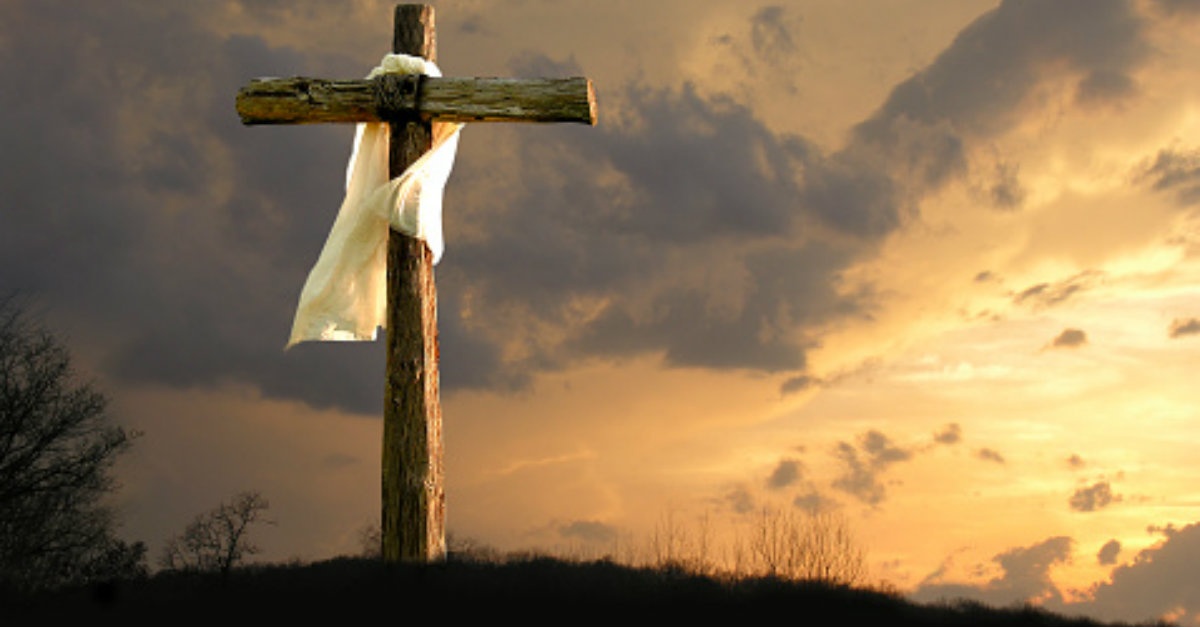
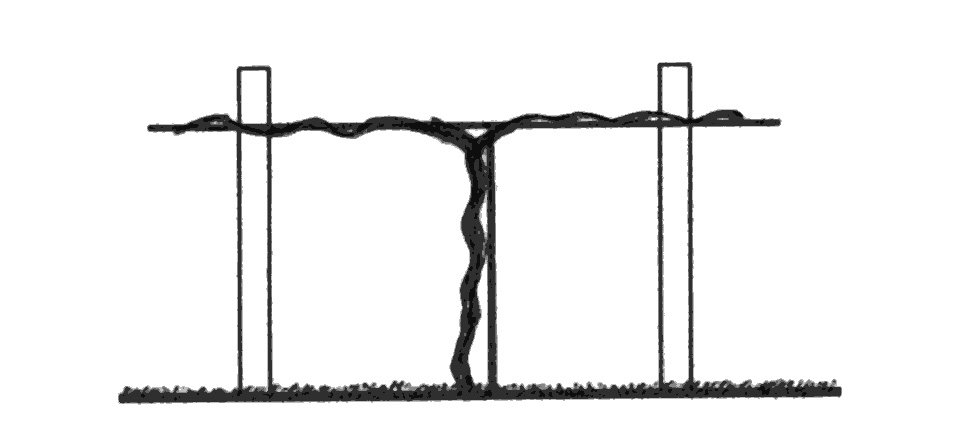
Jesus Predicts His Death
20And there were certain Greeks among them that came up to worship at the feast: 21The same came therefore to Philip, which was of Bethsaida of Galilee, and desired him, saying, Sir, we would see Jesus. 22Philip comes and tells Andrew: and again Andrew and Philip tell Jesus. 23And Jesus answered them, saying, The hour is come, that the Son of man should be glorified. 24Truly, truly, I say to you, Except a corn of wheat fall into the ground and die, it stays alone: but if it die, it brings forth much fruit. 25He that loves his life shall lose it; and he that hates his life in this world shall keep it to life eternal. 26If any man serve me, let him follow me; and where I am, there shall also my servant be: if any man serve me, him will my Father honor.
- A seed has to cease becoming a seed (die) in order to bear fruit
- A seed (the Word) contains instructions (The Law) and food (Jesus/bread of life) necessary to sprout life as a plant.
Hebrews 12 : Christ’s Sacrifice Once for All (Psalm 147:1-20; Romans 3:1-8)
1For the law having a shadow of good things to come, and not the very image of the things, can never with those sacrifices which they offered year by year continually make the comers thereunto perfect. 2For then would they not have ceased to be offered? because that the worshippers once purged should have had no more conscience of sins. 3But in those sacrifices there is a remembrance again made of sins every year. 4For it is not possible that the blood of bulls and of goats should take away sins.
5Why when he comes into the world, he said, Sacrifice and offering you would not, but a body have you prepared me:
6In burnt offerings and sacrifices for sin you have had no pleasure.
7Then said I, See, I come (in the volume of the book it is written of me,) to do your will, O God.
8Above when he said, Sacrifice and offering and burnt offerings and offering for sin you would not, neither had pleasure therein; which are offered by the law; 9Then said he, See, I come to do your will, O God. He takes away the first, that he may establish the second. 10By the which will we are sanctified through the offering of the body of Jesus Christ once for all.
11And every priest stands daily ministering and offering oftentimes the same sacrifices, which can never take away sins: 12But this man, after he had offered one sacrifice for sins for ever, sat down on the right hand of God; 13From now on expecting till his enemies be made his footstool. 14For by one offering he has perfected for ever them that are sanctified. 15Whereof the Holy Ghost also is a witness to us: for after that he had said before,
16This is the covenant that I will make with them after those days, said the Lord, I will put my laws into their hearts, and in their minds will I write them;
17And their sins and iniquities will I remember no more.
18Now where remission of these is, there is no more offering for sin.
Romans 6 : Dead to Sin, Alive to God (2 Corinthians 4:7-18)
1What shall we say then? Shall we continue in sin, that grace may abound? 2God forbid. How shall we, that are dead to sin, live any longer therein? 3Know you not, that so many of us as were baptized into Jesus Christ were baptized into his death?4Therefore we are buried with him by baptism into death: that like as Christ was raised up from the dead by the glory of the Father, even so we also should walk in newness of life. 5For if we have been planted together in the likeness of his death, we shall be also in the likeness of his resurrection: 6Knowing this, that our old man is crucified with him, that the body of sin might be destroyed, that from now on we should not serve sin. 7For he that is dead is freed from sin.
8Now if we be dead with Christ, we believe that we shall also live with him: 9Knowing that Christ being raised from the dead dies no more; death has no more dominion over him. 10For in that he died, he died to sin once: but in that he lives, he lives to God. 11Likewise reckon you also yourselves to be dead indeed to sin, but alive to God through Jesus Christ our Lord.
12Let not sin therefore reign in your mortal body, that you should obey it in the lusts thereof. 13Neither yield you your members as instruments of unrighteousness to sin: but yield yourselves to God, as those that are alive from the dead, and your members as instruments of righteousness to God. 14For sin shall not have dominion over you: for you are not under the law, but under grace.
- The Roots soaked in water for 2-3 hours before planting (3 years ministry)
- The Soil needs to be deep, well drained, and loose, with good circulation and sunlight.
Matthew 13 : The Parable of the Sower (Mark 4:1-9; Luke 8:4-15)
1The same day went Jesus out of the house, and sat by the sea side. 2And great multitudes were gathered together to him, so that he went into a ship, and sat; and the whole multitude stood on the shore.
3And he spoke many things to them in parables, saying, Behold, a sower went forth to sow; 4And when he sowed, some seeds fell by the way side, and the fowls came and devoured them up: 5Some fell on stony places, where they had not much earth: and immediately they sprung up, because they had no deepness of earth: 6And when the sun was up, they were scorched; and because they had no root, they withered away. 7And some fell among thorns; and the thorns sprung up, and choked them:8But other fell into good ground, and brought forth fruit, some an hundred times, some sixty times, some thirty times. 9Who has ears to hear, let him hear.
The Purpose of Jesus’ Parables (Mark 4:10-12)
10And the disciples came, and said to him, Why speak you to them in parables? 11He answered and said to them, Because it is given to you to know the mysteries of the kingdom of heaven, but to them it is not given. 12For whoever has, to him shall be given, and he shall have more abundance: but whoever has not, from him shall be taken away even that he has. 13Therefore speak I to them in parables: because they seeing see not; and hearing they hear not, neither do they understand.
14And in them is fulfilled the prophecy of Esaias, which said, By hearing you shall hear, and shall not understand; and seeing you shall see, and shall not perceive:
15For this people’s heart is waxed gross, and their ears are dull of hearing, and their eyes they have closed; lest at any time they should see with their eyes and hear with their ears, and should understand with their heart, and should be converted, and I should heal them.
16But blessed are your eyes, for they see: and your ears, for they hear. 17For truly I say to you, That many prophets and righteous men have desired to see those things which you see, and have not seen them; and to hear those things which you hear, and have not heard them.
The Parable of the Sower Explained (Mark 4:13-20)
18Hear you therefore the parable of the sower. 19When any one hears the word of the kingdom, and understands it not, then comes the wicked one, and catches away that which was sown in his heart. This is he which received seed by the way side.20But he that received the seed into stony places, the same is he that hears the word, and immediately with joy receives it;21Yet has he not root in himself, but endures for a while: for when tribulation or persecution rises because of the word, by and by he is offended. 22He also that received seed among the thorns is he that hears the word; and the care of this world, and the deceitfulness of riches, choke the word, and he becomes unfruitful. 23But he that received seed into the good ground is he that hears the word, and understands it; which also bears fruit, and brings forth, some an hundred times, some sixty, some thirty.
Dig a planting hole 12″ x 12″ (the grave)
- Fill with 4″ of Top Soil
- Trim off broken Roots
- Set the Vine into the Hole slightly deeper than it grew in the nursery.
- Cover the roots with 6″ of soil and tamp down.
- Fill the remaining soil but don’t tamp down
- Prune the top back to 2-3 buds at planting time.
- Water @ time of planting.
John 15 : Jesus the True Vine
1I am the true vine, and my Father is the farmer.2Every branch in me that bears not fruit he takes away: and every branch that bears fruit, he purges it, that it may bring forth more fruit.3Now you are clean through the word which I have spoken to you.4Abide in me, and I in you. As the branch cannot bear fruit of itself, except it abide in the vine; no more can you, except you abide in me. 5I am the vine, you are the branches: He that stays in me, and I in him, the same brings forth much fruit: for without me you can do nothing. 6If a man abide not in me, he is cast forth as a branch, and is withered; and men gather them, and cast them into the fire, and they are burned.7If you abide in me, and my words abide in you, you shall ask what you will, and it shall be done to you. 8Herein is my Father glorified, that you bear much fruit; so shall you be my disciples. 9As the Father has loved me, so have I loved you: continue you in my love. 10If you keep my commandments, you shall abide in my love; even as I have kept my Father’s commandments, and abide in his love.11These things have I spoken to you, that my joy might remain in you, and that your joy might be full.
Deuteronomy 5 : The Ten Commandments (Exodus 20:1-17)
6I am the LORD your God, which brought you out of the land of Egypt, from the house of bondage.
7You shall have none other gods before me.
8You shall not make you any graven image, or any likeness of any thing that is in heaven above, or that is in the earth beneath, or that is in the waters beneath the earth: 9You shall not bow down yourself to them, nor serve them: for I the LORD your God am a jealous God, visiting the iniquity of the fathers on the children to the third and fourth generation of them that hate me,10And showing mercy to thousands of them that love me and keep my commandments.
11You shall not take the name of the LORD your God in vain: for the LORD will not hold him guiltless that takes his name in vain.
12Keep the sabbath day to sanctify it, as the LORD your God has commanded you. 13Six days you shall labor, and do all your work: 14But the seventh day is the sabbath of the LORD your God: in it you shall not do any work, you, nor your son, nor your daughter, nor your manservant, nor your maidservant, nor your ox, nor your ass, nor any of your cattle, nor your stranger that is within your gates; that your manservant and your maidservant may rest as well as you. 15And remember that you were a servant in the land of Egypt, and that the LORD your God brought you out there through a mighty hand and by a stretched out arm: therefore the LORD your God commanded you to keep the sabbath day.
16Honor your father and your mother, as the LORD your God has commanded you; that your days may be prolonged, and that it may go well with you, in the land which the LORD your God gives you. 17You shall not kill. 18Neither shall you commit adultery. 19Neither shall you steal. 20Neither shall you bear false witness against your neighbor. 21Neither shall you desire your neighbor’s wife, neither shall you covet your neighbor’s house, his field, or his manservant, or his maidservant, his ox, or his ass, or any thing that is your neighbor’s.
28And the LORD heard the voice of your words, when you spoke to me; and the LORD said to me, I have heard the voice of the words of this people, which they have spoken to you: they have well said all that they have spoken. 29O that there were such an heart in them, that they would fear me, and keep all my commandments always, that it might be well with them, and with their children for ever! 30Go say to them, Get you into your tents again. 31But as for you, stand you here by me, and I will speak to you all the commandments, and the statutes, and the judgments, which you shall teach them, that they may do them in the land which I give them to possess it. 32You shall observe to do therefore as the LORD your God has commanded you: you shall not turn aside to the right hand or to the left. 33You shall walk in all the ways which the LORD your God has commanded you, that you may live, and that it may be well with you, and that you may prolong your days in the land which you shall possess.
12This is my commandment, That you love one another, as I have loved you.
1 Corinthians 13 : Love
4Love suffers long, and is kind; Love envies not; Love braggs not itself, is not puffed up, 5Does not behave itself unseemly, seeks not her own, is not easily provoked, thinks no evil; 6Rejoices not in iniquity, but rejoices in the truth; 7Bears all things, believes all things, hopes all things, endures all things. 8Love never fails: but whether there be prophecies, they shall fail; whether there be tongues, they shall cease; whether there be knowledge, it shall vanish away.
9For we know in part, and we prophesy in part. 10But when that which is perfect is come, then that which is in part shall be done away. 11When I was a child, I spoke as a child, I understood as a child, I thought as a child: but when I became a man, I put away childish things. 12For now we see through a glass, darkly; but then face to face: now I know in part; but then shall I know even as also I am known.
13And now stays faith, hope, love, these three; but the greatest of these is love.
Greater Love has No One than This
13Greater love has no man than this, that a man lay down his life for his friends. 14You are my friends, if you do whatever I command you. 15From now on I call you not servants; for the servant knows not what his lord does: but I have called you friends; for all things that I have heard of my Father I have made known to you. 16You have not chosen me, but I have chosen you, and ordained you, that you should go and bring forth fruit, and that your fruit should remain: that whatever you shall ask of the Father in my name, he may give it you. 17These things I command you, that you love one another.
The Hatred of the World
18If the world hate you, you know that it hated me before it hated you. 19If you were of the world, the world would love his own: but because you are not of the world, but I have chosen you out of the world, therefore the world hates you. 20Remember the word that I said to you, The servant is not greater than his lord. If they have persecuted me, they will also persecute you; if they have kept my saying, they will keep yours also. 21But all these things will they do to you for my name’s sake, because they know not him that sent me. 22If I had not come and spoken to them, they had not had sin: but now they have no cloak for their sin. 23He that hates me hates my Father also. 24If I had not done among them the works which none other man did, they had not had sin: but now have they both seen and hated both me and my Father. 25But this comes to pass, that the word might be fulfilled that is written in their law, They hated me without a cause.
26But when the Comforter is come, whom I will send to you from the Father, even the Spirit of truth, which proceeds from the Father, he shall testify of me: 27And you also shall bear witness, because you have been with me from the beginning.
Galatians 5 : Living by the Spirit (Romans 8:9-11)
16This I say then, Walk in the Spirit, and you shall not fulfill the lust of the flesh. 17For the flesh lusts against the Spirit, and the Spirit against the flesh: and these are contrary the one to the other: so that you cannot do the things that you would. 18But if you be led of the Spirit, you are not under the law. 19Now the works of the flesh are manifest, which are these; Adultery, fornication, uncleanness, lasciviousness, 20Idolatry, witchcraft, hatred, variance, jealousies, wrath, strife, seditions, heresies,21Contentions, murders, drunkenness, revelings, and such like: of the which I tell you before, as I have also told you in time past, that they which do such things shall not inherit the kingdom of God.
22But the fruit of the Spirit is
- love,
- joy,
- peace,
- long-suffering,
- gentleness,
- goodness,
- faith,
- 23Meekness,
- temperance:
against such there is no law. 24And they that are Christ’s have crucified the flesh with the affections and lusts.
25If we live in the Spirit, let us also walk in the Spirit. 26Let us not be desirous of vain glory, provoking one another, envying one another.
